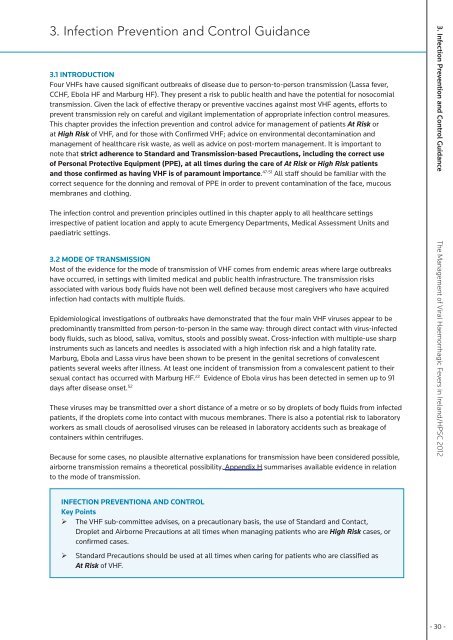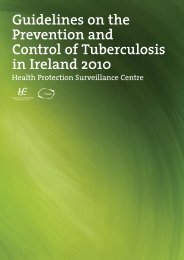The Management of Viral Haemorrhagic Fevers in Ireland - Health ...
The Management of Viral Haemorrhagic Fevers in Ireland - Health ...
The Management of Viral Haemorrhagic Fevers in Ireland - Health ...
Create successful ePaper yourself
Turn your PDF publications into a flip-book with our unique Google optimized e-Paper software.
3. Infection Prevention and Control Guidance3.1 IntroductionFour VHFs have caused significant outbreaks <strong>of</strong> disease due to person-to-person transmission (Lassa fever,CCHF, Ebola HF and Marburg HF). <strong>The</strong>y present a risk to public health and have the potential for nosocomialtransmission. Given the lack <strong>of</strong> effective therapy or preventive vacc<strong>in</strong>es aga<strong>in</strong>st most VHF agents, efforts toprevent transmission rely on careful and vigilant implementation <strong>of</strong> appropriate <strong>in</strong>fection control measures.This chapter provides the <strong>in</strong>fection prevention and control advice for management <strong>of</strong> patients At Risk orat High Risk <strong>of</strong> VHF, and for those with Confirmed VHF; advice on environmental decontam<strong>in</strong>ation andmanagement <strong>of</strong> healthcare risk waste, as well as advice on post-mortem management. It is important tonote that strict adherence to Standard and Transmission-based Precautions, <strong>in</strong>clud<strong>in</strong>g the correct use<strong>of</strong> Personal Protective Equipment (PPE), at all times dur<strong>in</strong>g the care <strong>of</strong> At Risk or High Risk patientsand those confirmed as hav<strong>in</strong>g VHF is <strong>of</strong> paramount importance. 47-51 All staff should be familiar with thecorrect sequence for the donn<strong>in</strong>g and removal <strong>of</strong> PPE <strong>in</strong> order to prevent contam<strong>in</strong>ation <strong>of</strong> the face, mucousmembranes and cloth<strong>in</strong>g.<strong>The</strong> <strong>in</strong>fection control and prevention pr<strong>in</strong>ciples outl<strong>in</strong>ed <strong>in</strong> this chapter apply to all healthcare sett<strong>in</strong>gsirrespective <strong>of</strong> patient location and apply to acute Emergency Departments, Medical Assessment Units andpaediatric sett<strong>in</strong>gs.3.2 Mode <strong>of</strong> transmissionMost <strong>of</strong> the evidence for the mode <strong>of</strong> transmission <strong>of</strong> VHF comes from endemic areas where large outbreakshave occurred, <strong>in</strong> sett<strong>in</strong>gs with limited medical and public health <strong>in</strong>frastructure. <strong>The</strong> transmission risksassociated with various body fluids have not been well def<strong>in</strong>ed because most caregivers who have acquired<strong>in</strong>fection had contacts with multiple fluids.Epidemiological <strong>in</strong>vestigations <strong>of</strong> outbreaks have demonstrated that the four ma<strong>in</strong> VHF viruses appear to bepredom<strong>in</strong>antly transmitted from person-to-person <strong>in</strong> the same way: through direct contact with virus-<strong>in</strong>fectedbody fluids, such as blood, saliva, vomitus, stools and possibly sweat. Cross-<strong>in</strong>fection with multiple-use sharp<strong>in</strong>struments such as lancets and needles is associated with a high <strong>in</strong>fection risk and a high fatality rate.Marburg, Ebola and Lassa virus have been shown to be present <strong>in</strong> the genital secretions <strong>of</strong> convalescentpatients several weeks after illness. At least one <strong>in</strong>cident <strong>of</strong> transmission from a convalescent patient to theirsexual contact has occurred with Marburg HF. 22 Evidence <strong>of</strong> Ebola virus has been detected <strong>in</strong> semen up to 91days after disease onset. 52<strong>The</strong>se viruses may be transmitted over a short distance <strong>of</strong> a metre or so by droplets <strong>of</strong> body fluids from <strong>in</strong>fectedpatients, if the droplets come <strong>in</strong>to contact with mucous membranes. <strong>The</strong>re is also a potential risk to laboratoryworkers as small clouds <strong>of</strong> aerosolised viruses can be released <strong>in</strong> laboratory accidents such as breakage <strong>of</strong>conta<strong>in</strong>ers with<strong>in</strong> centrifuges.Because for some cases, no plausible alternative explanations for transmission have been considered possible,airborne transmission rema<strong>in</strong>s a theoretical possibility. Appendix H summarises available evidence <strong>in</strong> relationto the mode <strong>of</strong> transmission.3. Infection Prevention and Control Guidance <strong>The</strong> <strong>Management</strong> <strong>of</strong> <strong>Viral</strong> <strong>Haemorrhagic</strong> <strong>Fevers</strong> <strong>in</strong> <strong>Ireland</strong>/HPSC 2012INFECTION PREVENTIONA AND CONTROLKey Po<strong>in</strong>ts‣ <strong>The</strong> VHF sub-committee advises, on a precautionary basis, the use <strong>of</strong> Standard and Contact,Droplet and Airborne Precautions at all times when manag<strong>in</strong>g patients who are High Risk cases, orconfirmed cases.‣ Standard Precautions should be used at all times when car<strong>in</strong>g for patients who are classified asAt Risk <strong>of</strong> VHF.- 30 -
















